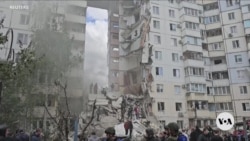Russian forces are expanding their attacks on Ukrainian border settlements close to the northeastern city of Kharkiv, opening up a new front in the war, as Kyiv struggles to hold off a renewed Russian offensive.
Speaking Thursday on a visit to Kharkiv, where he held a meeting with senior military leaders, Ukrainian President Volodymyr Zelenskyy said that the situation remained “extremely difficult” and that his forces were strengthening their presence in the region.
With U.S. and European weapons finally due to arrive on the front lines in the coming weeks, can Ukraine hold back Moscow’s invading troops?
Kharkiv offensive
Mobile units of Russian troops are attempting to capture Ukrainian villages including Vovchansk and Lyptsi, which lies 30 kilometers north of Kharkiv.
Ukraine has fired missiles from the border region into Russia, including deadly strikes on the Russian city of Belgorod. Moscow wants to stop the attacks, said defense analyst Patrick Bury of Britain’s Bath University.
“There's multiple reasons, I think, why Russia would try something here: obviously to create a buffer zone, but also to test the defenses and see what's going on. But the way (Russian forces) are set up — and the amount of troops that they have, maybe 30,000 to 40,000, not that much armor, attacking in small groups of infantry — it doesn't really suggest that they're trying to sort of encircle Kharkiv or anything like that,” Bury told VOA.
Russian advance
Kyiv said Thursday its defensive moves had slowed the speed of Moscow’s advance. Russian attacks are likely to continue, said analyst Jack Watling of the Royal United Services Institute in London.
“Russia’s aim is not to achieve a grand breakthrough, but rather to convince Ukraine that it can keep up an inexorable advance, kilometer by kilometer, along the front,” Watling wrote in an email to VOA.
“Having stretched the Ukrainians out, the contours of the Russian summer offensive are easy to discern. First, there will be the push against Kharkiv. Ukraine must commit troops to defend its second largest city and given the size of the Russian group of forces in the area, this will draw in reserves of critical material, from air defenses to artillery.”
“Second, Russia will apply pressure on the other end of the line, initially threatening to reverse Ukraine’s gains from its 2023 offensive, and secondly putting at risk the city of Zaporizhzhia. Ukraine should be able to blunt this attack, but this will require the commitment of reserve units,” Watling added.
Western weapons
Ukrainian forces are still waiting for the bulk of the weapons deliveries under the United States’ $60 billion aid package that was finally passed last month, after a six-month delay.
“The United States aid is crucial, so the unfortunate pause in the delivery of arms had a significant impact on the situation at the front and this is what we are seeing now,” said Ukrainian lawmaker Serhii Rakhmanin, a member of the Parliamentary Committee on National Security.
Ukraine says Russian jets and missiles are easily able to attack their positions, before infantry move in. Kyiv has repeatedly asked for more air defense systems, especially U.S.-made Patriot missiles. Germany has agreed to supply two Patriot batteries to Ukraine, and it’s reported that the U.S. is also working on supplying another unit.
The weapons will start to arrive in the coming weeks, analyst Patrick Bury said.
“The U.S. has pre-positioned stocks of stuff in Germany, for example, and also has strategic airlift so it can move stuff quickly over (from the US) should it need to,” he said.
“But it will take some time to be producing the number of shells that Ukraine needs at the moment, and they're outgunned at about at least five or six to one at the moment by Russian shells,” he added.
Mobilization
Last month, Ukraine passed a mobilization bill to address a shortage of personnel. RUSI’s Watling said Russia had amassed a force of 510,000 troops.
“This means that Russia has established significant numerical superiority over the Armed Forces of Ukraine,” he said.
The next three months will be crucial for Ukraine, according to lawmaker Rakhmanin.
“The Russians currently have a window of opportunity. The power of Ukrainian Armed Forces has decreased, and Russians feel it. They have amassed quite a sufficient amount of resources — weapons, ammunition, manpower and now they are trying to use up a maximum of their reserves. They are trying to spread our forces thin across the entire front line,” Rakhmanin told Reuters Wednesday.
Bleak outlook
Can Ukraine and its Western allies turn the tide of the war?
“The chances of them taking back significant territory now in the medium term seem to be slipping away,” said analyst Bury. “Unless there’s some sort of step change in Western support — a large force-generation package and a long-term strategy for what success looks like — none of which at the moment are forthcoming, then I think Ukraine stays on the defensive and holds what it has,” he said.
RUSI’s Watling agrees: “The outlook in Ukraine is bleak. However, if Ukraine’s allies engage now to replenish Ukrainian munitions stockpiles, help to establish a robust training pipeline, and make the industrial investments to sustain the effort, then Russia’s summer offensive can be blunted, and Ukraine will receive the breathing space it needs to regain the initiative.”





















